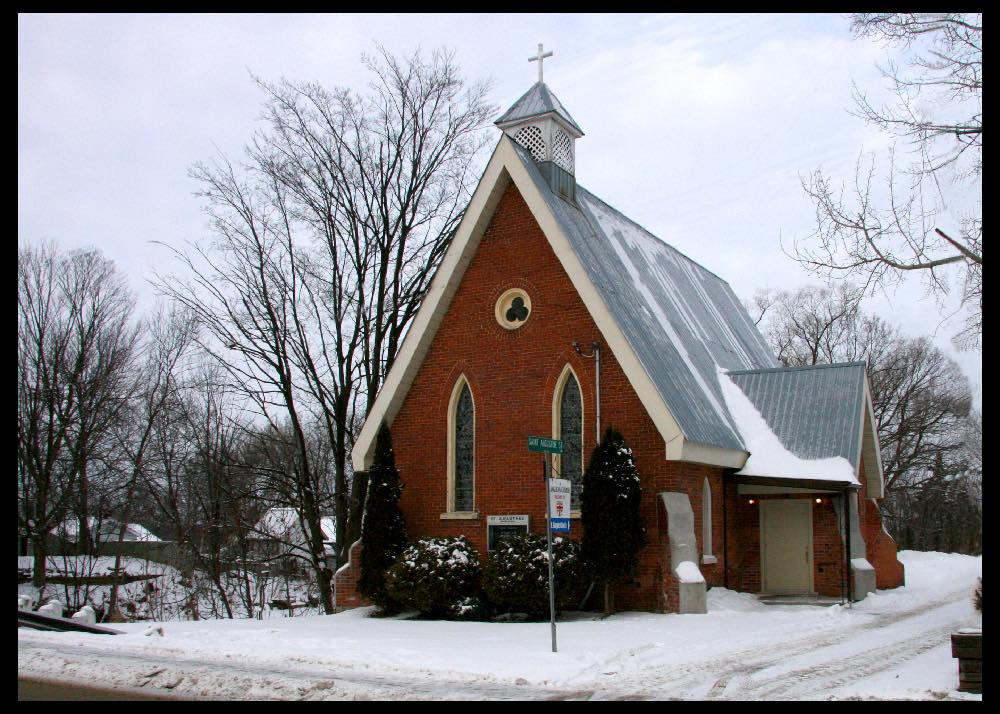What we see here seems straightforward enough. This is Saint Augustine’s Church, Beachburg, as photographed by Brian Glenn on 23 January 2007. So picture perfect is this photograph that it was chosen by Bishop John Chapman to grace his 2019 Christmas card. How could the good bishop possibly have guessed the intellectual Storm und drang controversy and discussion that lay behind this charming view of a traditional Anglican house of worship in the upper Ottawa valley? How indeed!
But first, let us appreciate the troubled early years of Saint Augustine’s Church, Beachburg. In 1863, an Anglican missionary meeting was held in Beachburg. Five years later, in 1868, the Mission of Beachburg was established, and the following year that mission was listed as consisting of stations at Beachburg, Cobden, Forester’s Falls, Stafford No. 1 (Saint Stephen’s, Micksburg) and Westmeath.
We are told that nothing succeeds like success. Or does it? From 1869 to 1876, Beachburg changed from a mission with five points to seven: Wilberforce was added in 1874, and Saint Patrick’s Stafford in 1876. In 1881, the Mission of Beachburg was dissolved, and we are left clutching a mystery. Beachburg, Forester’s Falls, Westmeath and Wilberforce were not listed in the Synod Journal. In 1882, the Beachburg mission was re-created, with services held at Beachburg and Cobden. Such was the state of things that the Beachburg services were held in an Orange Hall, but already the house of worship we see here was a-building. On 26 May 1883, Saint Augustine’s, Beachburg was opened by Bishop John Travers Lewis of Ontario.
Clearly this house of worship was built in the flood tide of building Gothic Revival churches across the Diocese of Ottawa. In the 1880s, some 27 churches were built. Saint Augustine’s was not among the more lavish examples of this style, which may partly account for its charm and for its durability. Its solid red brick construction, its lack of excess, the steep roof beams supported by sturdy angled buttresses at the corners all combined for a picturesque yet enduring country house of worship.
What is important is what you don’t see in this photograph. When Brian Glenn clicked the shutter to take this view, the resulting image included numerous hydro lines that made for an unlovely picture. It was only after patiently photo-shopping (a process by which undesirable elements are removed from a photograph) that he was able to produce the attractive photograph you behold here.
You’d think that would be an end of it. Not quite. While Brian Glenn worked away at removing hydro wires from this photograph, he doubtless thought of the then archivist’s bugbear about this being a form of lying. What the Archivist was saying, controversially, is that photo-shopping works against the truthfulness of a photograph, by removing elements from it. For Brian Glenn, it simply came down to making the picture look better by removing distractions that that get in the way visually. Those distractions prevent us seeing the church.
The Diocesan Archives collects parish registers, vestry reports, service registers, minutes of groups and committees, financial documents, property records (including cemeteries and architectural plans), insurance policies, letters, pew bulletins, photographs (photo-shopped or not), paintings, scrapbooks, parish newsletters, and unusual records.


St. James, Morrisburg — Stormont Deanery